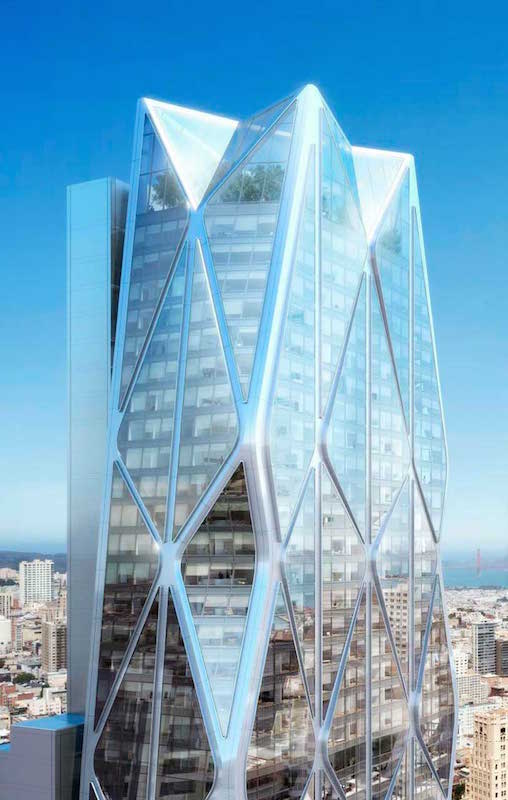A November groundbreaking is scheduled for the 2.3-million-sf Oceanwide Center in San Francisco that, when completed, will be part of this city’s ambitious creation of a new Transbay neighborhood that includes more than 6 million sf of new downtown office space in a high-density commercial core surrounding the new five-story Transbay Transit Center.
The San Francisco Planning Commission has granted planning permission for Oceanwide Center, consisting of two towers—a 605-foot-high building for a hotel and residences, and an 850-foot-tall office and residential building—that will be located within a 22,000-sf lot in the South of Market Street (SOMA) district. The designers are Foster + Partners and Heller Manus Architects.
Foster + Partners states that this project will include new public spaces and pedestrian connections that are designed to support increased density, which is one of the goals of the larger Transbay development. Kathryn Gustafson of the firm Gustafson Guthrie Nichol is Oceanwide Center’s landscape architect.
The ground level of the buildings will be “lifted up” by almost five stories to provide the neighborhood with an “urban room” with walking routes cutting through the site, and leading to shops, cafes, and green spaces.
“This development will be the new exemplar of urban living with exciting places to live and work right alongside the central transport hub,” sayd Stefan Behling, Foster + Partners’ Senior Executive Partner.
Beijing-based Oceanwide Holdings acquired this site in early 2015, according to the website Hoodline.com. The plans would require tearing down three buildings. The developer also intends to renovate two existing commercial buildings on First Street. Hoodline reports that Oceanwide Center will include 265 residential units, 169 hotel rooms, 12,500 sf of ground-floor retail, and 26,000 sf of privately owned public open space.
The Transbay Redevelopment Project has three interconnected elements:
- Replacing the former Transbay Terminal at First and Mission Streets
- Extending Caltrain and California High Speed Rail underground from Caltrain’s current terminal at 4th and King Streets into the new downtown Transit Center
- Creating a new neighborhood of homes, offices, parks, and shops surround the Transit Center.
The first phase will create a new five-story Transit Center with one above-grade bus level, ground-floor, concourse, and two below-grade rail levels serving Caltrain and future California High Speed Rail. Phase I will also create new bus ramp that will connect the Transit Center to a new off-site bus storage facility and the San Francisco-Oakland Bay Bridge.
The Transit Center is designed by Pelli Clarke Pelli Architects (PCPA), and will feature a 5.4-acre park on the roof of the bus and rail station. A complementary transit tower designed by PCPA and developed by Hines will be built adjacent to the Transit Center and will provide additional financing for the project.
Aside from the new office space, other highlights of the Transbay redevelopment plan include:
- Nearly 4,400 units of new housing, 1,200 of which will be permanently affordable.
- Approximately 100,000 sf of new retail space, much of it in the Transbay Transit Center.
- Nearly 1,000 new hotel rooms.
- A dramatic new skyline punctuated by a limited number of taller buildings, including a 1,070-foot-tall Salesforce Tower, the tallest in San Francisco, adjacent to the Transbay Transit Center.
- Wide sidewalks with landscaping, lighting, seating, and pedestrian amenities.
- Mid-block crossings keyed to alleyway systems and other pedestrian safety improvements.
- Safe and convenient bicycle lanes.
- A total of more than 11 acres of new public parks and open space.
According to the San Francisco Planning Department, the Transit Center District Plan and the Transbay Redevelopment Plan will generate more than $2.7 billion in net additional public funding for the construction of the Transbay Program and affordable housing in the Transbay neighborhood. Together, the Plans will generate more than 25,000 construction job-years and 27,000 permanent jobs.
 One of Oceanwide Center's towers, at 805 feet, will be the second tallest in San Francisco. Image: Foster + Partners
One of Oceanwide Center's towers, at 805 feet, will be the second tallest in San Francisco. Image: Foster + Partners
Related Stories
High-rise Construction | Aug 22, 2016
Tall buildings with a twist: CTBUH ranks the world’s 28 tallest twisting towers
In 2005, the Turning Toroso, designed by Santiago Calatrava, was completed, making it the first twisting skyscraper in the world.
High-rise Construction | Aug 1, 2016
Rising to the occasion: Dubai shows some pictures of proposed 500-step structure
Still in the planning stages, this building would serve tourists and power climbers alike.
High-rise Construction | Jul 26, 2016
Perkins+Will unveils plans for what will be Atlanta’s second-tallest tower
The 74-story 98 Fourteenth Street will be a mixed-use building with retail space and luxury residential units.
Concrete | Jul 20, 2016
Arup ensures Mexico City concrete skyscraper can withstand seismic activity
Double-V hangers and irregularly spaced gaps allow the structure to bend.
High-rise Construction | Jul 15, 2016
Zaha Hadid designs geometric flower-shaped tower for sustainable Qatar city
The 38-story building will have a mashrabiya latticed facade with hotel and residential space inside.
High-rise Construction | Jul 14, 2016
New San Francisco mixed-use tower billed as most earthquake-resistant building on the West Coast
A megabrace is a key seismic component at 181 Fremont, with offices, residences, and retail space.
High-rise Construction | Jul 14, 2016
Shigeru Ban designs tower expected to be world’s tallest hybrid timber structure
To lessen the carbon footprint, Terrace House in Vancouver will be made of wood sourced from British Columbia.
High-rise Construction | Jul 12, 2016
Three-tiered, 57-story high-rise development from Arquitectonica coming to Miami
The structure will be the tallest building in the Edgewater District
Office Buildings | Jul 11, 2016
CetraRuddy designs office tower for Manhattan’s Meatpacking district
Plans originally called for a hotel, but the architect and developers adapted their design for commercial use.
Contractors | Jul 4, 2016
A new report links infrastructure investment to commercial real estate expansion
Competitiveness and economic development are at stake for cities, says Transwestern.
















